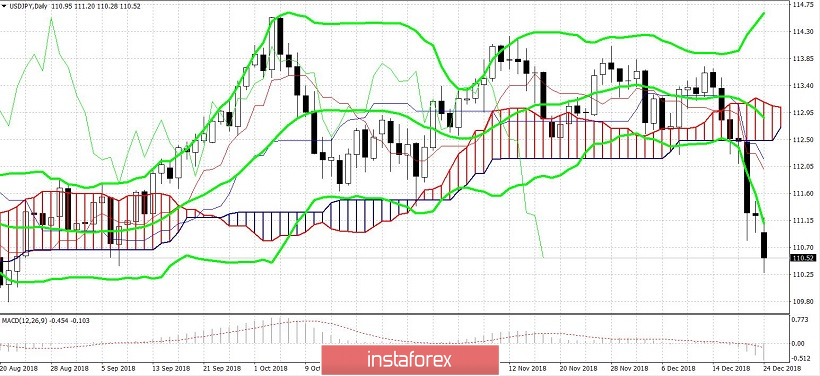The yen paired with the US currency is storming the 110th mark today, continuing to demonstrate a southern momentum. Last week, the USD/JPY fell by more than 200 points, so today's price dynamics in general does not surprise anyone. Although the pair tried to develop a corrective growth this morning, this attempt failed: the dollar is still under the pressure of the fundamental background.
And it's not just the Federal Reserve, which at its last meeting voiced a rather soft position – traders are nervous about the shutdown and about Trump's critical remarks about the Fed, as well as the recent actions of the US Treasury Secretary, which we will discuss below. In conditions of low liquidity, these factors determine the agenda, influencing the dynamics of the main currency pairs. In general, the market is dominated by anti-risk sentiment, thus, defensive tools are beginning to benefit from increased demand. Due to this circumstance, the yen conquers multi-month lows, trying to gain a foothold within the tactically important mark of 110.
The so-called shutdown came last Saturday, when US government agencies cease their activities for a certain period. The US Congress was unable to agree on the country's budget – the stumbling block was the allocation of money for the construction of the wall on the border with Mexico. Political bidding ended in failure, although until recently, representatives of the Democratic Party expressed their readiness to support Trump's initiative in exchange for legislative protection of illegal immigrants imported to the United States in their childhood. At first, the American President was positive about this idea, but then put the question in an ultimatum. The reaction of the Democrats was easy to predict: they ignored Trump's blackmail, after which the shutdown became a reality.

As a rule, such situations do not cause a strong panic in the markets: in the last five years there have already been several shutdowns that lasted for a relatively short time: the congressmen adopted a temporary budget for the duration of the discussion of the main issue.
According to most experts, this situation will not exhaust itself this year, although initially it was said that the government agencies will resume their work this Thursday. Most likely, the shutdown will last until January 3, 2019, when the Democrats will gain control of the House of Representatives. They will be able to unblock the government, as it has been repeatedly in similar situations: for example, at the beginning of this year, the shutdown lasted three days – from January 20 to 23, after which the legislators several times adopted a temporary budget, until the end of March. At the end of this period, the parties were able to agree (then politicians were arguing about military spending), and this issue was finally removed from the agenda.
At the moment, the situation is more complicated: the Democrats are categorically against the allocation of five billion dollars for the construction of the wall between Mexico and the United States. In this case, it is difficult to even talk about options for a compromise solution, as politicians take an irreconcilable position, being at different poles of understanding the situation. It is worth noting here that the market is most concerned not with the fact of the shutdown itself, but with the increasing political opposition in the United States. After the midterm elections, when Congress was "divided" between Republicans and Democrats, many warned that uncertainty in the country would only increase. Therefore, traders are "in anticipation" of the next political season, when the deputies elected in November will take up their duties.
In addition to the shutdown, the market is concerned about another circumstance: during the weekend, the Minister of Finance announced that American credit organizations had enough liquidity. And although the very fact of this statement was supposed to calm the markets, the effect was the opposite. The fact is that Steven Mnuchin answered the question that, in general, no one asked. The head of the department linked this situation again with the shutdown, but in previous times the Ministry of Finance did not hold such consultations with the largest banks in the country. In other words, the unexpected debate on this issue has caused some dissonance in the "thin" market, putting additional pressure on the dollar.
And this is despite the fact that traders have not moved away from the events of the past week, when the Fed announced a slowdown in the pace of the rate hike. The combination of fundamental factors has led to the fact that the yield of 10-year-old treasuries fell to the level of 2.763%, and the dollar index to 95.53 points. The Japanese currency paired with the dollar also reflects the dynamics of the foreign exchange market, reaching the level of 110.28 (however, then followed by a corrective pullback). In conditions of low liquidity, the pair can continue to decline: the yen enjoys the status of a defensive asset, while the dollar has fallen into the zone of turbulence throughout the market.

The factors mentioned above will put pressure on the greenback, opening the way for USD/JPY to the bottom of the 110th figure. Impulsively, the pair may go lower, but the mark of 110.00 is still quite a powerful support. Therefore, from the base of this figure, you can consider long positions - if you prefer to trade in the conditions of the pre-holiday unnatural volatility.
The material has been provided by InstaForex Company -
www.instaforex.com